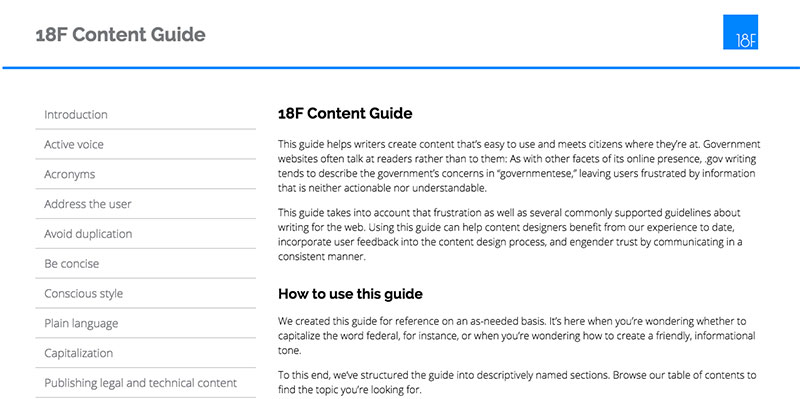18F recently introduced its series of guides, a collection of best practices for our internal project teams. As Mike Bland writes in his post describing the guides, “Though these guides currently carry the 18F brand, the intention is to spread the use and cultivation of the material throughout the broader U.S. Digital Service effort.”
To that end, we’re proud to announce the release of our 18F Content Guide, a comprehensive handbook to help content creators on our team (and, we hope, elsewhere) create more direct, accessible, and compelling written works. Per the Plain Writing Act of 2010, agencies across government (including the General Services Administration) have been working hard to improve the clarity and accessibility of their content. We’re thrilled to be contributing to this ongoing mission.
You are our intended audience
We wrote this guide for content creators of all stripes: content designers and strategists, bloggers, comms folks, and anyone else who has a hand in the production of written works.
We realize that content creators bring to the table different strengths and approach the creative process from different contexts. In organizations without formalized content standards, these divergences can cause tension. Adopting a content style guide — especially one a team modifies substantially to better meet its needs — is a good way to set a baseline from which to work. Setting such a baseline allows teams to shift their focus from debating capitalizations (to cite a common example, and one we’re all too familiar with) to producing top-quality content in a timely manner.
Our guide is for everyone, and we’ve written it to be as inclusive as possible. We use plain language and a friendly, informative tone to appeal to the widest possible audience.
How to use the guide
We’ve divided our guide into easy-to-navigate sections titled after the topics they cover. Though some people might prefer to read the guide from start to finish, we encourage users to skip around a bit, finding topics of immediate interest and continuing to browse from there.
Additionally, we’ve also included links to other great style guides that informed our work — they’re listed at the end of the guide in the References section. And we owe much to Gov.uk, whose style guide we used as a jumping-off point for our own.
The guide is a living thing
Though we’re proud of the work we’ve done, we’re equally thrilled at the prospect of folks making copies of our guide and changing them however they like.
We’re of the mind that the best style guides are living documents — modifiable, customizable frameworks that change with the organization they’re a part of. Content guides exist to help people easily convey their organization’s values; holding on to guides that no longer reflect organizational values can lead to the creation of unclear or inaccurate content, which is what we’re all trying to avoid.
All this is to say we hope you’ll take this guide and use it as you see fit, especially if that use involves revisions and reconfigurations.
Now taking suggestions
If you’ve got thoughts on how we might improve the guide, please send them our way — we’d love to hear from you!


